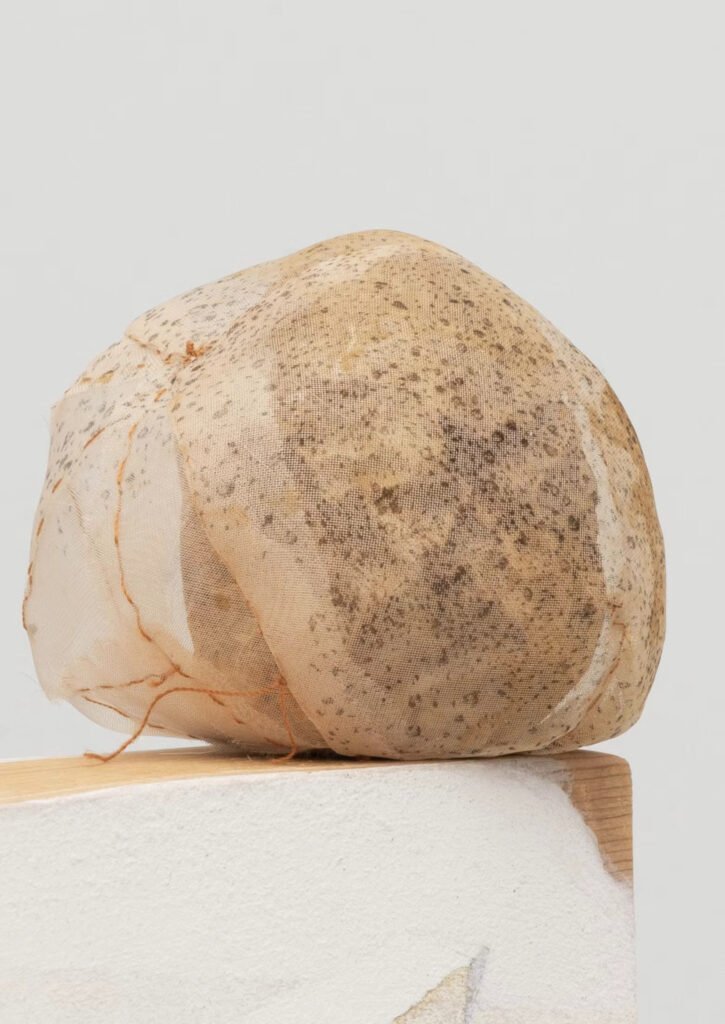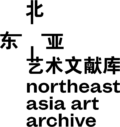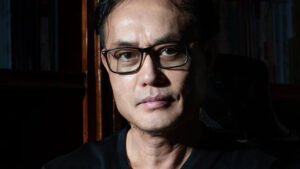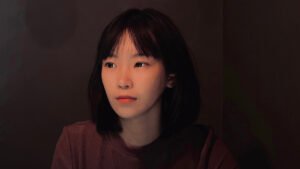
We met Hu Xiaoyuan on a willow-fringed spring afternoon.
She is leaner and quieter than expected, echoing a sense of space that suggests the high degree of closeness and unity an artist can achieve with her work.
I don’t know why, but at the beginning of the interview, we began talking about this time two years ago. Hu Xiaoyuan talked her experience before the opening of her solo exhibition at the West Bund Museum Shanghai. She was setting up the exhibition in Shanghai and had to escape from the emergency lockdown of her hotel in a terrible mess, making her way through the basement, blockade chains, and every nook and cranny before she was finally able to escape the quarantine and show up for the opening ceremony.
At that moment, we were all in a trance: it was only two years ago, but it seemed so far away, those days had passed, and talking about it again and again seemed so out of place. The fact that we seemed to be laughing when we heard a certain detail makes everything look more like a joke. But being out of place is just fine and on this afternoon, Hu Xiaoyuan comforted us with her story.
Toward the end of the interview, the wind suddenly picked up, and the air was covered with poplar flakes like a heavy snowfall. Hu Xiaoyuan had a slight cough due to her allergies, but she said: What a romantic afternoon.
We all laughed when she said it. It was as if she was revalidating the pessimism she had always felt with an unexpected humor: that language is too impoverished and awkward, and that human experience cannot be replicated or communicated.
Leaving space, both as a result of abstraction and as a working method, permeates Hu Xiaoyuan’s works and public discourse, forming a highly recognizable “silence”: the restraint and detachment of the creative language, the contradiction and discernment contained in the materials of natural and everyday objects, the abstraction from the mundane life and its joys and sorrows, the essence of existence achieved through repeated tempering, filtration and refinement… Facing the pain of the moment, Hu Xiaoyuan has no intention of becoming the fastest and loudest voice, but rather to leave traces and provide revelations and solutions to the future as far away as possible.
I have to say, this is such an ambition, or even a dangerous path. But relationships will eventually fall apart, and the individual will always be lonely. This is exactly the hidden but ever present expressions in Hu Xiaoyuan’s creations. More than once, she talked about the dismal she felt due to the lack of language and the shackles and she had to create her own words – ant bone, stone doubt, serenely positioned world – to depict those works more precisely. She chooses to return to art when words fail. In her creations, in her flexible use of materials, and in injecting women’s and individuals’ experiences into her works, Hu Xiaoyuan found her own spot, where she wants to stay, grow, and become who she wants to be.
As the first Chinese female artist to be invited to the “Documenta” in Kassel”, Hu Xiaoyuan’s artistic path may be fortunate in its own way. But this uniqueness and clarity is not so much a choice against the established rules of rebellion and abandonment, but rather a kind of “inevitability” after realizing her own limitations. This is precisely the more profound understanding of Hu Xiaoyuan’s artistic path and way of life that we have after talking to her. Although in Hu Xiaoyuan’s view, words themselves are full of ambiguities, our conversation with her makes us feel like as if we are following her through the storm, from the quagmire to the shore, and finally standing on the calm seaside.
Standing is almost the only gesture in Hu Xiaoyuan’s installations. With inspiration from everyday objects, she wraps expired bread and passion fruit into thin, cicada-like raw silk fabric, incorporating wire, wooden frames and concrete structures, which are meticulous and full of tension, appearing to be shaky but at the same time exceptionally sturdy and stable. It takes effort to build these time-consuming creations which are tested over and over again and must even undergo complex mathematical calculations to achieve their stability and beauty. But Hu Xiaoyuan enjoys it, saying that she doesn’t excel in many things but art accommodates her sensitivity, her silence and even her clumsiness, something she can do until the last minute of her life. This is truly a blessing, even though she has traveled through brutal storms and prolonged slumps before acquiring this luck.
But Hu Xiaoyuan knows that she is becoming calmer and more mellow and in the process of clarifying herself, she is also re-understanding the people around her, her relationships, and the world in which she lives.
This conversation with Hu Xiaoyuan began with the “New Voices of Northeast China” project, a joint project by ARTDBL and the Northeast Asia Art Archive, in which we hope to ask questions of those creators who are connected with Northeast China in terms of their identities, thresholds, and scenes of creativity, and to try to distill the lines and texture of Northeast China’s contemporary narratives.
As the first artist invited to the “New Voices of Northeast China” feature, Hu Xiaoyuan, who is from Harbin, presents us with various aspects of her “incompatibility” as an atypical North-easterne, whether it be the stale, boring life she lived in the region for the first 15 years of her life, the migratory lifestyle after she fled from her native experience in Northeast China at the age of 15, or the introversion and social fear engraved in her bones, or even “intentionally” leaving blank her native experience in her artistic creation, all of them tell the special nature of Hu’s relationship with Northeast China.
In the interview, Hu Xiaoyuan told us about the cold, aloof Northeast in her memory, the last glimpses of the Republic’s eldest son through the bus window before the end of his prosperity, and the loss and regrets of today’s Northeast that she did not return to on an artistic level, but which she empathized with again and again in the writings of Shuang Xuetao and Ban Yu. While trying to find the regional commonality, we also see in Hu’s stories of Northeast China the control, the loss of control, the darkness and the painful youth that she has endured as a result of her individual experience, and this cruelty also determines the immense blankness of her relationship with Northeast China.
But Hu Xiaoyuan says there is nothing wrong with blankness. If the artist’s past was forged by her years in the Northeast, then, in the self-exile of leaving her hometown and constantly fighting against the established inertia, Hu Xiaoyuan has gradually realized: “I know who I used to be, and I know I can be who I am now.”

The Monsters
Socializing seems to be more and more a task given to artists in this era, as an artist who does not socialize, are you afraid that you are not present?
HU Xiaoyuan: We should not generalize based on my own experience. But it is true that so far, no exhibition has opened because I have a close connection with someone. I’m a stay-at-home person and I hardly post on social media; I’m not good at socializing, and I don’t come up with things to say. So again, it goes back to the limitation, that is I can only do what I’m good at and there’s always the right opportunity for me. So I don’t agree with the the idea that if you don’t socialize then you’re not present. Does being present really matter?
You’re from Harbin, and it seems the North-easterners we are familiar with are quite socially savvy…
HU Xiaoyuan: A region, to a certain extent, could have an unshakable impact. For example, my mother has been pickling her own sauerkraut every year since she came to live in Beijing, but it always fails because Beijing’s cabbages come from Shandong province, which are too big and too watery, unlike the cabbages from the Northeast, which are smaller and contain less water, and a series of factors such as temperature and seasonality determine the success or failure of the sauerkraut.
Just like constellations and life numbers, the essential differences between in- and out-of-place will ultimately be reflected in the individual, such as cabbage, for example, and such as numerous animals and plants.
You think that North-easterners are socially savvy and I don’t deny that. But I’d actually say that there are more complex factors apart from that, such as individual differences, native experiences, and more. Maybe it’s because people have watched too much country romance and accepted those so-called typical traits that border on labeling, but the truth is that humans are highly individualized beings, making it impossible to understand the whole picture by only seeing a part.
In the Northeast, there are monsters like me, and many, many more.
When it comes to northeasternness, there seems to be quite a blank in your relevant expression on a creative level?
HU Xiaoyuan: Actually, the original experience we just talked about has decided that it will be a blank. Before I turned 15, my life was planned, the almost two-point linear existence with all my time spent at home or at school during the day, and in painting or tutoring classes at night. There is no other redundancy. My deepest impression of Harbin is the road I traveled back and forth on.
I was a pitiful kid learning to draw. At first, I took painting classes in the city Youth Palace, surrounded by high school students ready to take the college entrance exam, and I was only 12 years old, no one cared about me; In the first year of junior high school, I began learning color painting in the Juvenile Palace where I became the oldest student in class, surrounded by five and six-year-olds but still, no one cared about me. Looking back, perhaps I only went to the zoo once in the first 5 years of my life and it was actually an organized spring trip by my parents’ employer, Other than that, I don’t recall anyone ever taking me out to play. There was a river where I lived, but I never rowed a boat there.
Have you ever been to Harbin? Except for the streets of Central Avenue, the whole city feels very detached and cold, especially in winter. It’s not easy for people to gather and huddle up, particularly in the city. If it’s not a family compound, neighbors don’t know each other. Even in summer, it can be cold after it rains, but the wind is strong so the rain dries up quickly. Plus there is a river, so it rains even more, and the days are short. From October to April, it’s impossible to stay outside, let alone gathering at night to cool off and chat like people in the south do.
Yes, it is true that there are many blanks, but blanks have their own benefits. During my youth, I found myself in a prolonged state of isolation, which fostered my detached personality and habit of solitude.
The detachment or observation present in your work seems to be indeed related to the region upon reflection.
HU Xiaoyuan: I do have a lot of restraint. The reason why this restraint seems less northeastern is because the so-called set northeastern qualities are too widespread, but people like me from the northeast wouldn’t talk to you about the so-called portrayal of the Northeast in the Spring Festival Gala.
I remember when Diao Yinan’s “Black Coal, Thin Ice” first won the award, some people questioned him for vilifying Harbin, because they thought the scenes and landscapes in his camera were so depressed that they looked like the 1980s. But I know, that’s what Harbin really looks like.
The first year I came to Beijing from Harbin at the age of 16, I was disappointed. Although I know now that the sooner you leave your family, the better, for myself, who had just escaped from the inertia of my family at that time, seeing six people living in a shabby dormitory with tattered beds, the feeling of disappointment was immense. I remember seeing Beijing for the first time when I came out of the Beijing station and thinking it was so old-fashioned. At that time, Harbin was a trading port, and still has the former glory. You know what I like to do in winter? Sitting on the bus, I could see a lot of Russian girls in mink coats with their legs exposed along the way, walking on the busy Central Avenue. Their legs were red from the cold, and their faces were also flushed. They looked so stylish, very beautiful.
When you come to Beijing from a city like that, you will only feel that everywhere is gray and colorless, and there are sandstorms from time to time, and you can’t breathe anywhere. But then the Northeast lost its lure and became very depressing. If you walk down Central Avenue now, you’ll notice that only the outward-facing sides of the buildings are decorated. But once you turn around, you’ll see that the backs of these buildings are already deteriorating, on the brink of collapse.
There is no such thing as a constant era, and in constant change, people’s perceptions change. The scary thing is that people’s perceptions of the Northeast have been pushed really hard by the times, and as a result tend to override the plurality of the region, thus creating a bias. This bias also has a very bad effect on the region and as a result, causing its symbiosis and plurality to shrink more and more and eventually centralize in a kind of crude northeasternness.
Would you empathize with the loss and decline narrated in the Northeast Renaissance and this sorry telling over the years?
HU Xiaoyuan: It’s actually relatively good, a new profile. Years ago, when I returned to Harbin and got into a cab, Zhao Benshan must have been on the radio. Then you realize it is crazy when a hilarious urban culture is spreading everywhere. Then Shuang Xuetao and Banyu came along but I had long since passed the stage of being a novel lover. But I still finished reading them by listening to the audio book and I thought it was really good because they offered a new perspective of the Northeast and its localities, which had previously been covered by Zhao Benshan and people alike. I admit that they are not without merits but once they cover too long a period, with too high a density, and with too much production, the whole thing begins to lack substance. What today’s young writers from Northeast China are offering is a more nuanced and contemporary flavor, as well as new possibilities.
After I walked out of the Northeast, I actually know very little about it today, and looking back at the Northeast, what I feel is indeed the kind of negativity and exhaustion expressed by the new generation of creators. This exhaustion in particular echoes the general environment, not just China but also the global retreat. Ten years ago, could you have imagined that abortion would one day be illegal?

The Sentient
At the beginning of the interview, you talked about your experience two years ago, and the concrete and small feelings that come with this reality shock seem to be not heavily portrayed in your work?
HU Xiaoyuan: I do like to think about human nature in a more macroscopic and long-term way that transcends the nearness of time and space. However, if you look at history, you will find that many people, when in a helpless and powerless situation, tend to choose a more abstract and macroscopic way to cope with it. For example, the Chinese painter Huang Gongwang in the Yuan Dynasty, and the Western composer Eric Satie, both of whom seemed out of place and out of time due to their contradictions with the politics and realities of their times. But when we look back today, we find that their thoughts and creations often transcend the long vein and thread of time and space. Thus, at the human level, they formed a myriad of shared emotions with us who are distant in time.
When we were talking about the pandemic and how I was stuck in a hotel and almost didn’t make it to the opening ceremony, you can’t say that it didn’t bother me; on the contrary, the hairs on my back stood up at the time. But I have to figure out a better way to react to this situation. If I just say something, I’m worried it will quickly be forgotten, much like how we’re joking about it today. It’s been a year and a half, and the situation has evolved to where the past is somewhat relevant but feels like a distant memory. So, speaking up about something that faded away very quickly certainly won’t be much of an impact. Just like facing the current, what you have to do is not to control the current, but to teach yourself how to swim. I am willing to pull myself away from reality a little bit further, so that I can see things more clearly.
Does the process of abstraction do damage to real and concrete experience?
HU Xiaoyuan: It depends on how you describe damage, and how to define it as damage but not a part of the change itself? For example, the series of works I created at M+ in 2019, titled “Stone Doubt,” can be interpreted in many different ways by viewers. However, I believe I am exploring the concept of reality. The so-called reality, in my understanding, is never a constant node but a process that can’t be grasped.
We often say that seeing is believing, you believe in that moment and recognize it as the so-called standard concept, but that moment may be the biggest obstacle for you to perceive the real nature of the whole event.
On the flip side, maybe it’s not so much that people want to emphasize a certain standard, but rather that the damage caused by what we perceive to be true in a certain moment is so severe that it takes a very long time to come out of that emotional and mental state, or perhaps even to remain stuck and not come out at all. But as someone who has chosen to continue to exist, even if it is painful, it is a logical possibility that I must accept. I may not be able to do it, but I know that this is the right way. I’m not heartless, I’m actually too sentient that I can see things as they are.

The Encounter
You seem to have said that you no longer impose a certain way of expressing your work to the audience.
HU Xiaoyuan: I used to be very lonely. When I was younger, I always wished that I wasn’t alone, and I looked forward to having deeper connection with someone. But later, with age and with a little more understanding of existence, I realized that everyone is an individual. Just like the bystander effect experiment many years ago, there is actually no such thing as a group that can exist independently of interests; if interests are met in the short term, the group exists, but if not, the group dissipates, as it is variable.
So what I seek is not a mere absence of loneliness, but a brief encounter. If I want to express A with this work, but you see C, then we meet somewhere between A and C and it is not so bad.
What happened between longing for connection and seeking a brief encounter?
HU Xiaoyuan: It may have something to do with experience. After you’ve experienced the closest shared relationship, both physically and psychologically (for me, it’s the mother-child relationship), you will gradually realize as the little person grows up that there is a kind of irresistible distance between people and their emotions, and that it will continue to fall apart as the person becomes an independent individual. So very often, the relationship between two people can only be superficial and relatively symbiotic.
With the accumulation of experience, I now see all this clearly. Knowing that loneliness is only a realistic form of existence, I no longer have any emotions because of it, nor am I pessimistic about it. I have always believed that language, whether it be speech or writing, is very, very thin and impoverished when used for communication, because it is imprecise and because it relies on the mechanism of communion. Since people can’t produce individualized interactions with each other, it’s better to be alone.
What is the biggest impact that pregnancy and child-raising have had on your artistry?
HU Xiaoyuan: Before I had a baby, I had a relatively violent and aggressive attitude towards the world. After seeing so much gloom and doom, it seemed like I would quickly develop a stance and attitude. I would suddenly feel angry and negative, and think, “Whatever, it’s none of my damn business, it’s bad enough anyway”.
But the biggest shift brought by my baby is that I’ve realized that the world seems to be relevant to me. It’s not that it wasn’t relevant. It was, but in a bad way. And now I seem to be able to have a relatively benign relationship with the world, and I want to do something about it. Often, like when I was writing something for a new exhibition recently, there are moments when I quietly watch the slow and steady breathing of my sleeping child. Suddenly, tears would well up in my eyes as I realize how fleeting this moment of beauty is, knowing it will be gone by the time I wake up the next day. Sometimes, the photo app on my phone will send videos from several years ago. We watch the videos and have a good laugh. It’s hard to describe how you feel in that moment, you feel awesome, but after you say that, the moment is gone, and it’s brutal. And I didn’t feel that way about the world before I became a mother. Back then, all I wanted was just for this moment to pass quickly, to hurry up and explode into the past.
Have you ever felt it was difficult to return to the creative scene after becoming a mother?
HU Xiaoyuan: Never. Two days before my cesarean section, I had a two-hour interview, and on the same day I finished the last piece of artwork for my solo exhibition that was to open in a month, and then I went to the hospital in the evening. I had originally agreed to have a normal delivery, but I had to have an emergency surgery because the umbilical cord was wrapped around the baby’s arms and legs. After giving birth, the doctor asked me to take 42 days off for the wound to recover, but my solo exhibition in Beijing Commune opened in less than 30 days, and then the exhibition never stopped… In my heart, it seems like there is a timetable pushing me all the time, so that I can’t leave my creation. Hard work is inevitable. In the beginning, I was also quite passive, but then I quickly became proactive, and I intentionally maintain a continuous relationship with the creation.
Because I vaguely realized that my hormones and maternal obsession were causing some small deviations in me, both psychologically and physically. For example, in the later film “In the Beginning, I Stood at the End,” there was breast milk frozen for five years that was not consumed by the child. Shouldn’t I try to keep a close connection with my work? Let me block out this kind of confusion brought about by maternal obsession and inertia. The experience I’ve accumulated over the years makes it seem as if I have a consciousness and ability to calibrate myself. Because I’ve had the worst experience, and I know what that deviation will look like if it gets bigger.
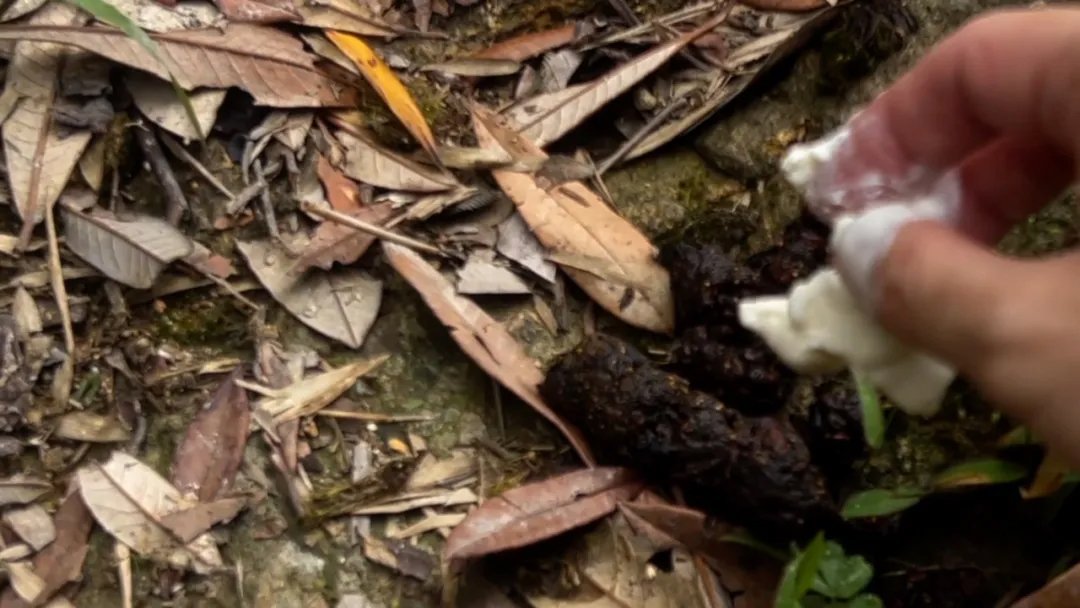
The Inertia
It would be interesting to hear about the mother-daughter relationship that you have experienced. For example, your choice of raw silk as the material for your work is a reflection of your mother. Is there a contrast between your relationship with your child and your relationship with your mother?
HU Xiaoyuan: Yes. But these two sets of relationships are very contradictory. I rarely talk about my relationship with my mother. It is the reason why I once formed a very intense, pessimistic and negative perception of the world. Then I repaired myself on my own and read a lot of books about psychology. I gave myself a diagnosis and I studied myself in order to see more clearly who I really am, what I want to do, and how I want to exist.
When comparing the two sets of relationships, it is actually the previous one that fostered a healthy relationship between me and my child. I believe it is possible to block out some of the inertia of what once was in the generational cycle to create a new possibility.
It is not easy to put a stop to this cycle.
Xiaoyuan Hu: Because I realized what this cycle was doing to me, and I wanted it to end here. It was probably almost two years ago that I really clarified the issues within the scope of life. The whole process has been a very long one and has brought about very many profound experiences.
In psychology, we say that there is a family spell. In fact, the so-called spell is a kind of inertia in family relationships that is hard to reverse. If you think about it, you will hardly remember all those great principles that your parents instilled in the past. What you can clearly remember is often how they steamed egg custard, how they cooked fish, how they folded clothes… basically all daily and trivial things. You unconsciously replicate it all. And the so-called spell is the inertia that is so hard to get out of no matter how well thought out and subjectively controlled you are.
Sometimes we wonder, why do girls keep falling for bad boys? Then you look at her relationship with her parents, look at her father and realize that it’s not that she doesn’t know the boy is not good for her, it’s not that she doesn’t know it’s going to hurt, it’s that she’s still in a kind of inertia, which makes her feel safe. Instead, the good relationship is something she has never experienced, perceived, or felt before. She gets scared and she can’t get in. I’ve had those moments of going towards the inertia of experience, but once I figured myself out, I didn’t want to let that inertia continue in my daily life anymore.
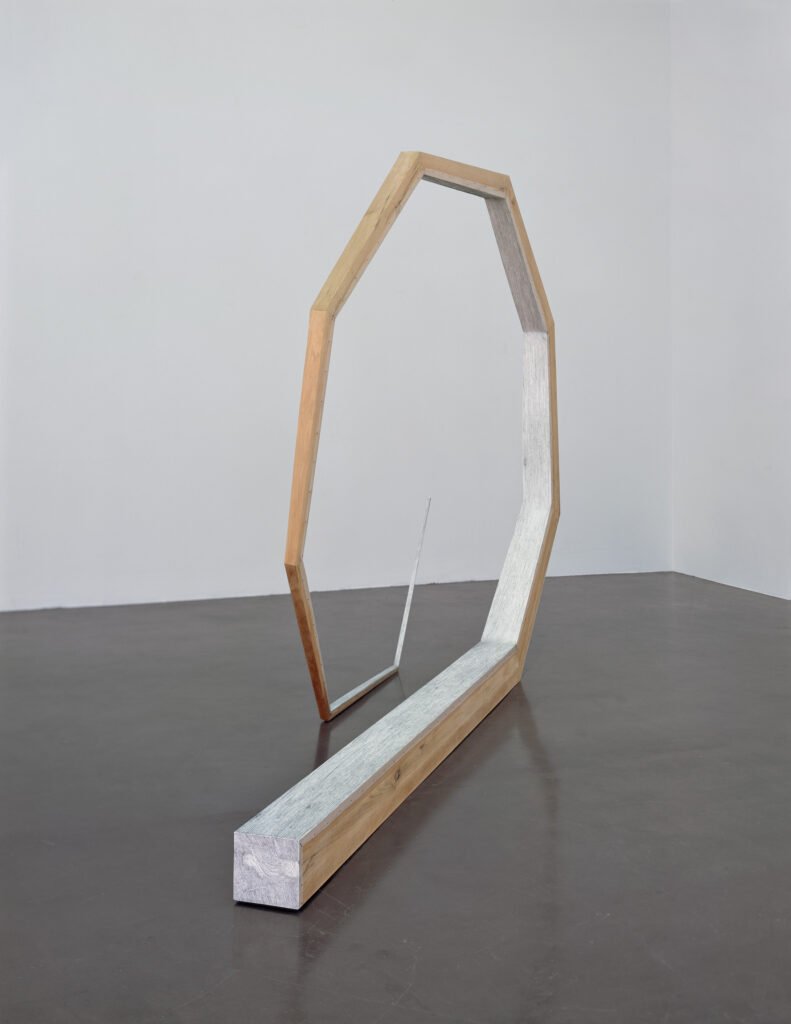
The Fortunate
What is the role of art in the long process of clarifying yourself?
HU Xiaoyuan: First of all, I’m an introvert, and I’m a bit reluctant to socialize. Art is just the right way for an introvert to restore order to himself or herself, not only to sort out one’s thoughts, but also to put them into a focused and fruitful behavioral pattern, to ultimately form a visual presentation and output. In fact, during a particularly obscure and difficult phase of my life, art was a drug-like existence for me. Later, when I climbed out of that quagmire, art became more of a more precise means than words and language to express and to question.
So for me, the role of art does change. Once it was the necessary catharsis of my emotions, sorting out and storing my inner turmoil. Today, it may still retain a bit of this function, but at the same time, it provides a bigger and wider space for me to think and make my voice heard in a visual way. And no matter how much it changes, the importance of art remains the same to me; it is something that can be done without external interference up until the last moment of my life.
At one point, I also tried to see whether I could give up my self-existence, not trying to be a deserter, but actively giving up. But I don’t want to do that anymore. Maybe it’s because I found the right place for myself in art; I just want to be here, and I am not going anywhere. It doesn’t matter who is my audience and who isn’t. What’s important is that I’m going to stay here and grow into who I want to be.
I suddenly feel incredibly fortunate that there is art.
HU Xiaoyuan: I think I’m relatively lucky that I graduated more than twenty years ago at a good time. Young artists who have just surfaced today are facing the downward spiral of the whole era, and the pressure they feel is immense. This existing pressure could be overwhelming. On one hand, you have very little time to think about the issues related to the essence of real existence, and on the other hand, this kind of downward pressure also makes many opportunities very difficult to judge.
At the same time, a lot of things today are strongly seductive to the new generation. Although for those who have been through it all, this is nothing but bullshit and illusion, being young makes it difficult to identify the essence. Each era has its own pain points, and whether you step on it or not is directly related to individual’s desire. But you can’t ask a person in their twenties to be complete without desire, it’s not possible. So stumble back where you fall. Only by overcoming this yourself will you truly understand what kind of process existence is, and whether it is interesting or not.

Committing Crimes
Your work gives me a sense of precariousness. Is it just my illusion?
HU Xiaoyuan: On the second floor of my studio, there are a few small and delicate pieces of work. Their bases are quite steep, but the overall height is very tall. A curator asked me when he saw them: Have you ever thought of hanging these pieces? I had never thought about it before he asked and I had never done it. As you can see, all my artworks, no matter how visually precarious and on the verge of collapse they may appear, remain standing on their own. To be honest, it’s not an easy job. All the works have been tested mechanically in the studio before they are exhibited, and they are very stable without any problems. But his question made me think of my own understanding of existence. Why does it look so shaky, but still remains very firm and independent? Maybe I have subconsciously been thinking that I have to stand there on my own to achieve some kind of integrity. I don’t want to rely on external forces to “fish for” something, even if it could appear bigger and seemingly more solid.
How do you perceive the everydayness in the materials of your work, and what is the purpose of preserving this everydayness in the process of turning it into art?
HU Xiaoyuan: This question reminds me of director Nuri Bilge Ceylan’s new film “About Dry Grasses”. This movie might provide a better interpretation of your question, and some of the methods and mediums used seem to resonate with my own approach. The first two-thirds of the film narrate reality in a very trivial and tedious way, but the final third completes a reversal of “realism.” At this point, you realize that the earlier portrayal of reality serves as a prelude to discussing abstract topics such as the human predicament. Ultimately, the director aims to address very broad issues that come along once the human element is abstracted.
The ready-made objects in my works are all used, with traces of individual existence and intersections on an experiential level, but this is not the essence of my discussion. I am only using these experiences to verify an existential process, and at the same time, I want to discuss broader issues that go far beyond the current topic. This is about dilemmas, hopes, or hidden secrets of a much longer vein.
Then what is important to you?
HU Xiaoyuan: Leaving some traces of my existence. I didn’t have such an ambition in the beginning, and I never thought of it as the ultimate goal of my existence, because then I would have been someone who shows her will through incessant promotion. Although I don’t have this desire, creation itself is still an expression. Whenever I put my works in the public space, I get the feedback and gain some interactions or exchanges. As a post-70s artist, I hear artists in their 20s say that they are influenced by me. Don’t you think these relationships are traces of existence? I never wanted this, but it seemed to have happened quietly anyway.
Existence itself, to some extent, always involves some degree of material interaction with the world. From the perspective of forensic science theory, every crime leaves traces, so I’ve always been committing crimes, and have created many cases. I never thought about what I have left behind, but there will always be some traces.
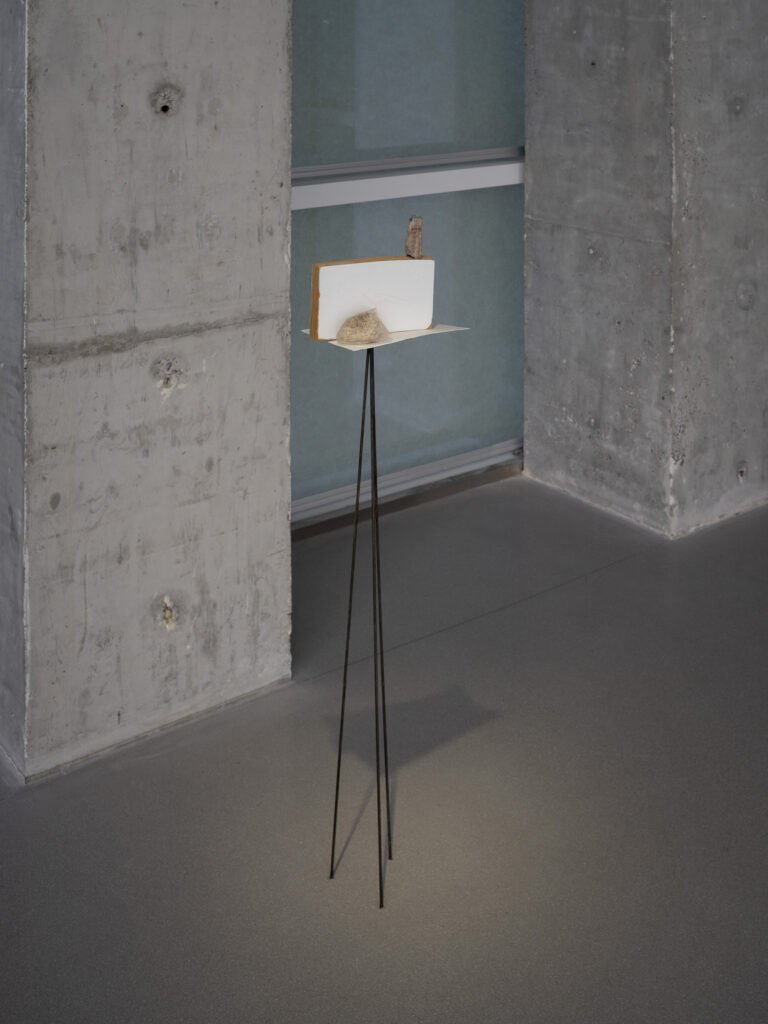
The Wrapping
Something in your work that particularly struck me was the act of the wrapping, the collision between the different materials, and the final culmination, all of which have a strong maternal embrace metaphor.
HU Xiaoyuan: A big part of the wrapping you mentioned comes from human nature. I am a highly sensitive person, and this sensitivity brings about a lot of distress, such as easily empathizing with a lot of things that seem insignificant to others, compelling myself into vulnerability. Although I have tried to guide myself as much as possible to adopt better behavioral patterns in order to avoid hurting myself, at the same time, it will naturally resurface again as part of my nature, which can’t be suppressed, because suppression itself can lead to imbalance.
I used to feel resentment and even anger facing a lot of structural violence, whether it be gender, power or issues within the art system. But now I try to shift my perspective, like you said, by wrapping up or blending in. I want to make a little bit of effort within my ability, to soften or wrap up the structural violence so that it is not too sharp and prickly. This is what I desire to do.
It seems that there’s a bit more freedom now. How does this kind of freedom relate to the uncontrolled freedom you experienced when you first arrived in Beijing at the age of 15?
HU Xiaoyuan: When I first came to Beijing to go to the affiliated middle school, I was the biggest trouble in class. Anything that can’t be done was done by me during the four years there because I wanted to know what it feels like.
By the time I went to college, everyone in my class thought I would probably become the best designer, but I chose art after graduation.
I was quite a rebel during all those years in school. The more you think I’m going be a certain way, the less I’m going toward that direction, and I’m going to show you that I’m only right if I’m not like that and I can exceed your imagination. I think this is the legacy of a contentious relationship with my mother. Back then, all rebellion was an impulse and had only one purpose: to validate that I was right. This freedom was actually a disguised unfreedom, always revolving around an object so strong that all I could do was circle around it, making seemingly free trial and error.
Let’s say that if decades ago, I was someone others wanted me to be, never truly knowing myself, not clear about who I was and what I wanted out of life, then now I’m slowly starting to understand myself. After seeing myself more and more clearly, all of the resistance that doesn’t seem to be cooperating with the system is the result of the choices I’ve made, my subjective and clear judgments, and no longer a blind attempt.
Your current WeChat profile picture is still the picture of yourself after shaving your head many years ago. How do you feel about that time now?
HU Xiaoyuan: I can realize or imagine how hard it was, but at the same time, I think that phase was actually really necessary. It’s a feeling that only people who have survived a catastrophe can relate. It must have been terrible if you didn’t make it through, but going through it all is what gives me valuable insight and experience. I know I used to be like that, and I also know I can be like this now.
